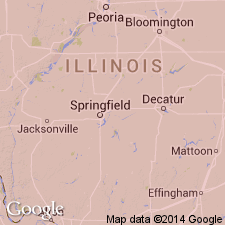
- Usage in publication:
-
- Hardinsburg
- Modifications:
-
- First used
- Dominant lithology:
-
- Sandstone
- AAPG geologic province:
-
- Illinois basin
Summary:
Hardinsburg shown on stratigraphic chart. "Moderately fine-grained, yellowish-brown sandstone; small amount of shale; thickness 80-100 feet." Underlain by Golconda formation; overlain by Sloans Valley formation. [Name Hardinsburg apparently first used in an abstract of Bulletin 35 published in 1916 (Preliminary oil report on southern Illinois: Illinois Geological Survey Extract of Bulletin 35). Extract could not be located in library.]
Source: GNU records (USGS DDS-6; Reston GNULEX).
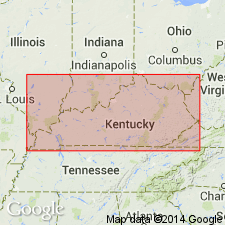
- Usage in publication:
-
- Hardinsburg sandstone
- Modifications:
-
- Named
- Dominant lithology:
-
- Sandstone
- AAPG geologic province:
-
- Illinois basin
Summary:
Named Hardinsburg sandstone for exposures near Hardinsburg, Breckinridge Co., north-central KY. Composed predominantly of sandstone which is usually thin-bedded and flaggy, rather fine-grained and hard, and somewhat argillaceous and ferruginous. Thickness ranges from 20 to 40 ft. Underlain by Golconda limestone; overlain by Glen Dean limestone.
Source: GNU records (USGS DDS-6; Reston GNULEX).
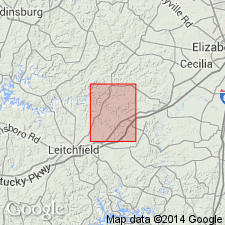
- Usage in publication:
-
- Hardinsburg Sandstone*
- Modifications:
-
- Overview
- AAPG geologic province:
-
- Illinois basin
Summary:
Designated Hardinsburg Sandstone. "Sandstone, thin- to thick-bedded; white, yellow, or brown; fine-grained; well-sorted; weathers dark brown; apparently unfossiliferous; iron-staining common; in places upper half contains massive sandstone beds 10 to 20 feet thick; lowest beds commonly stained brick red on weathered surface. Locally contains gray shale or interbedded platy siltstone and shale as much as 3 feet thick." Thickness ranges from 40 to 60 ft. Underlain by Haney Limestone Member of Golconda Formation; overlain by Glen Dean Limestone.
Source: GNU records (USGS DDS-6; Reston GNULEX).
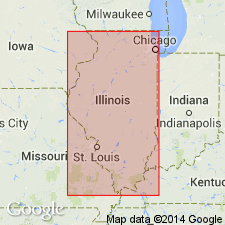
- Usage in publication:
-
- Hardinsburg Sandstone
- Modifications:
-
- Overview
- AAPG geologic province:
-
- Illinois basin
Summary:
Hardinsburg Sandstone is current (1975) usage of Illinois Geological Survey. "The formation has a thick-bedded sandstone facies and a thin-bedded, flaggy, shaly sandstone and shale facies. The sandstone in the Hardinsburg is largely light gray, very fine grained, friable, and in part calcareous." Commonly 50 to 100 ft thick. Underlain by Haney Limestone; overlain by Glen Dean Limestone.
Source: GNU records (USGS DDS-6; Reston GNULEX).
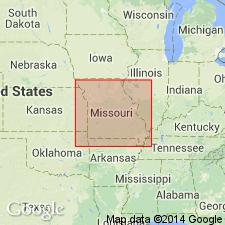
- Usage in publication:
-
- Hardinsburg Formation
- Modifications:
-
- Overview
- AAPG geologic province:
-
- Illinois basin
Anderson, K.H., 1979, Geologic Map of Missouri: Missouri Geological Survey
Summary:
Current (1979) usage of Missouri Geological Survey is Hardinsburg Formation. Recognized in southeast MO. Lumped with other Chester units on map.
Source: GNU records (USGS DDS-6; Reston GNULEX).
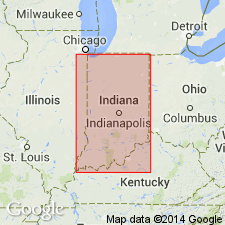
- Usage in publication:
-
- Hardinsburg Formation
- Modifications:
-
- Overview
- AAPG geologic province:
-
- Illinois basin
Summary:
Hardinsburg Formation of Stephensport Group is preferred usage of Indiana Geological Survey in 1986. In IN, unit "is characteristically gray soft carbonaceous shale and very fine grained ripple-bedded sandstone that is cliff-forming in some places." Thickness on surface ranges from 20 to 62 ft and is thicker and contains more sandstone in subsurface. Exposed on surface in Indiana from central Green Co. southward to the Ohio River. Overlies Haney Limestone, conformably in most places. Overlain conformably by Glen Dean Limestone or disconformably by Mansfield Formation (Morrowan).
Source: GNU records (USGS DDS-6; Reston GNULEX).
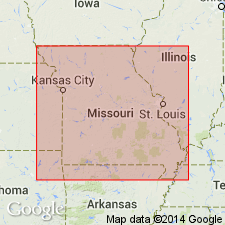
- Usage in publication:
-
- Hardinsburg Formation
- Modifications:
-
- Overview
- AAPG geologic province:
-
- Illinois basin
Summary:
Current (1986) usage of Missouri Geological Survey is Hardinsburg Formation. In MO, it consists of dark gray shale or plastic clay which contains quartzose sandstone streaks in the upper part. Outcrop is limited to poor exposures in east-central Perry Co., MO, near the Mississippi River bluffs. Thickness ranges from 13 to 20 ft but may reach 30 ft. Underlain by Golconda Formation; overlain by Glen Dean Limestone.
Source: GNU records (USGS DDS-6; Reston GNULEX).
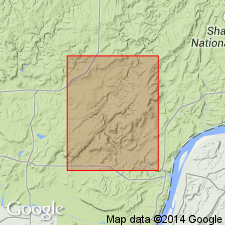
- Usage in publication:
-
- Hardinsburg Sandstone
- Modifications:
-
- Revised
- AAPG geologic province:
-
- Illinois basin
Summary:
The Pope Group, here revised from Megagroup and apparently reinstated, comprises strata from the base of the Aux Vases Sandstone to the top of the Kinkaid Formation, which includes the Hardinsburg Sandstone. According to authors, "The Pope Group is a lithostratigraphic unit distinct from its chronostratigraphic counterpart, the Chesterian Series." The lower boundaries of the two differ slightly. The group is about 1,425 ft thick in the Waltersburg quad, but the lowermost formations, from the Aux Vases Sandstone up to the Fraileys Shale Member of the Golconda Formation do not crop out. This interval is 384 ft thick in the Austin Roberts No. 1 Well. [See subunit list in index portion of Pope summary record. Publication does not name the units between the Aux Vases and the Fraileys and therefore these have not been included in the list.]
Source: GNU records (USGS DDS-6; Reston GNULEX).
For more information, please contact Nancy Stamm, Geologic Names Committee Secretary.
Asterisk (*) indicates published by U.S. Geological Survey authors.
"No current usage" (†) implies that a name has been abandoned or has fallen into disuse. Former usage and, if known, replacement name given in parentheses ( ).
Slash (/) indicates name conflicts with nomenclatural guidelines (CSN, 1933; ACSN, 1961, 1970; NACSN, 1983, 2005, 2021). May be explained within brackets ([ ]).

